Globalisation and Tesco: Risks, Opportunities, and Strategies
VerifiedAdded on 2023/06/07
|13
|4475
|61
Report
AI Summary
This individual academic report provides an executive summary of the impact of globalisation on Tesco, a multinational retailer. The report begins by defining globalisation and its key drivers, such as cultural exchange, improved transportation, and increased competition. It then provides a brief overview of Tesco, highlighting its business operations and its expansion into global markets. The main body of the report discusses the application of relevant theories and models of globalisation, including transformationalism and Marxism, to understand Tesco's business. It also explores the opportunities and risks associated with globalisation for Tesco, such as market expansion, increased competition, and the need to adapt to different cultural contexts. Finally, the report critically evaluates management strategies that Tesco could employ to address the identified issues, such as adapting to local cultures, managing supply chains, and investing in innovation. The report concludes by summarizing the key findings and recommendations. The report also delves into the opportunities and risks associated with globalization, such as unemployment and the need to adapt to local cultures. It analyzes management strategies that Tesco could employ to overcome such issues and maintain its position in the global market.
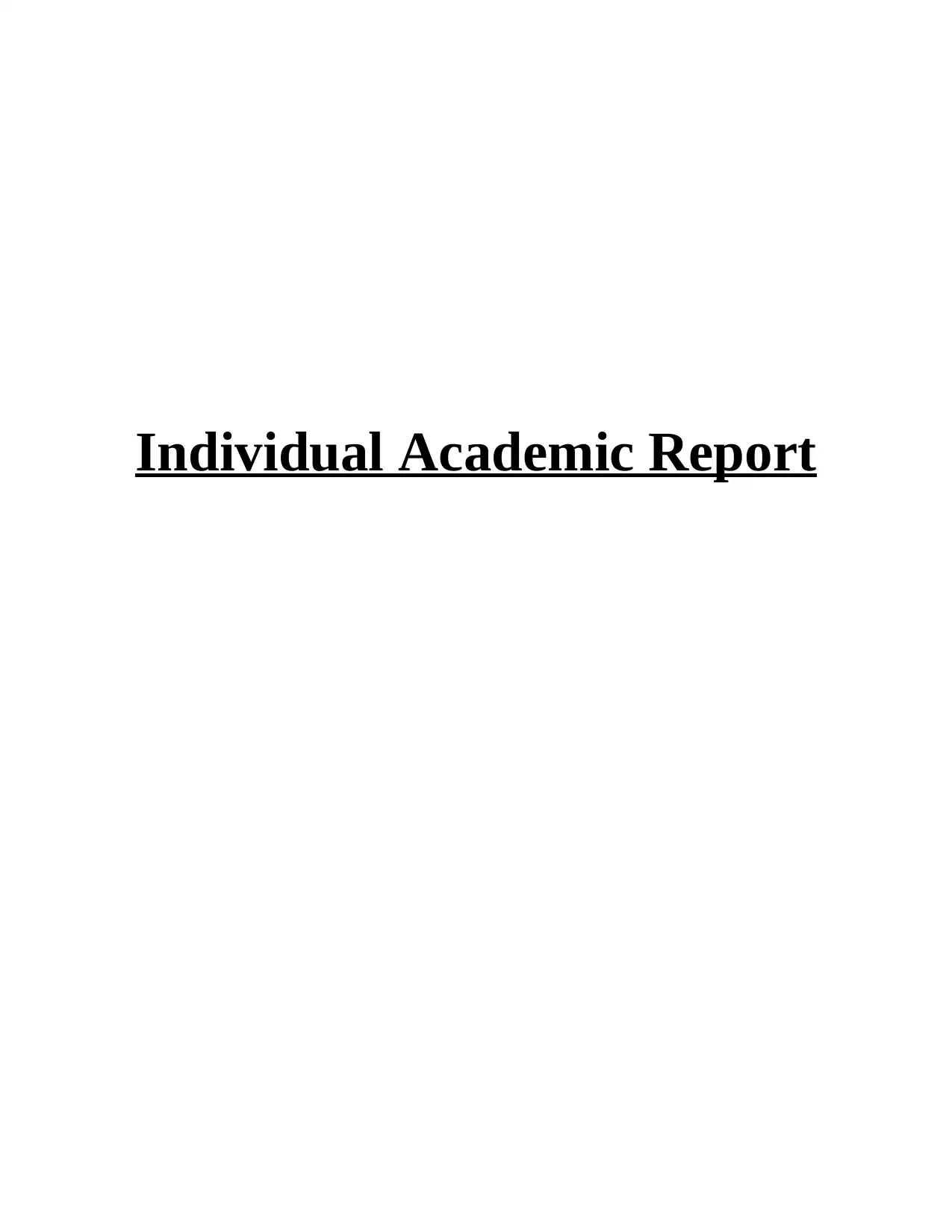
Individual Academic Report
Paraphrase This Document
Need a fresh take? Get an instant paraphrase of this document with our AI Paraphraser
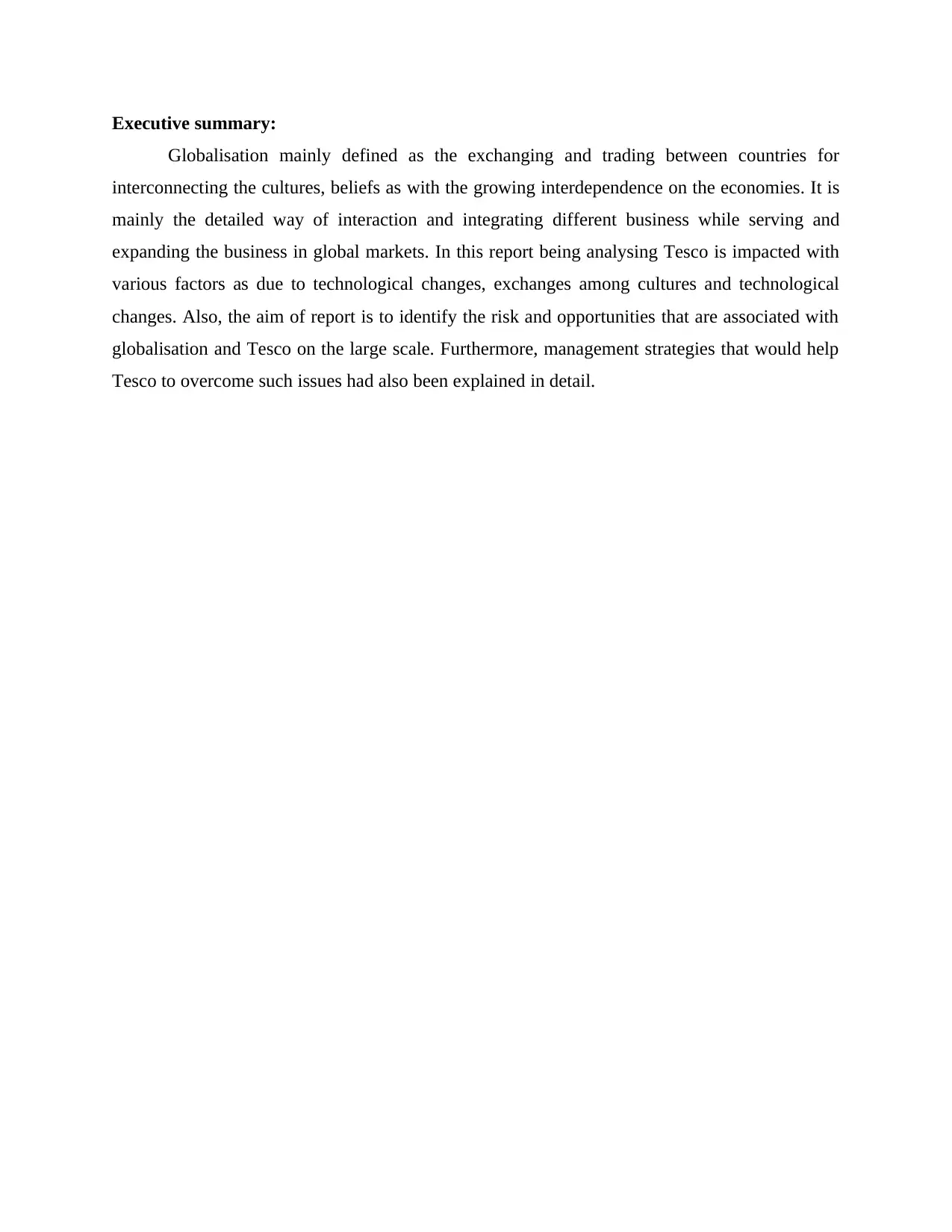
Executive summary:
Globalisation mainly defined as the exchanging and trading between countries for
interconnecting the cultures, beliefs as with the growing interdependence on the economies. It is
mainly the detailed way of interaction and integrating different business while serving and
expanding the business in global markets. In this report being analysing Tesco is impacted with
various factors as due to technological changes, exchanges among cultures and technological
changes. Also, the aim of report is to identify the risk and opportunities that are associated with
globalisation and Tesco on the large scale. Furthermore, management strategies that would help
Tesco to overcome such issues had also been explained in detail.
Globalisation mainly defined as the exchanging and trading between countries for
interconnecting the cultures, beliefs as with the growing interdependence on the economies. It is
mainly the detailed way of interaction and integrating different business while serving and
expanding the business in global markets. In this report being analysing Tesco is impacted with
various factors as due to technological changes, exchanges among cultures and technological
changes. Also, the aim of report is to identify the risk and opportunities that are associated with
globalisation and Tesco on the large scale. Furthermore, management strategies that would help
Tesco to overcome such issues had also been explained in detail.
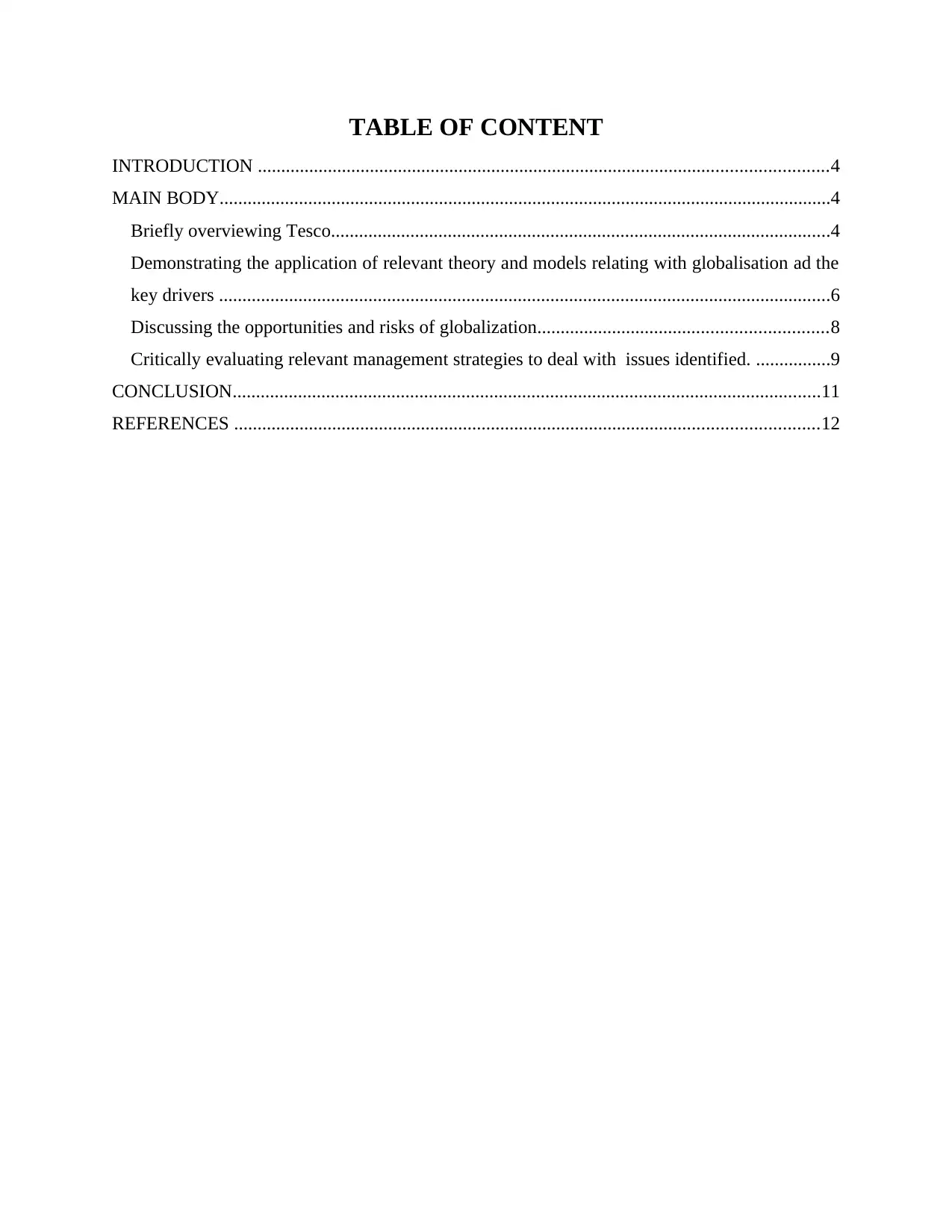
TABLE OF CONTENT
INTRODUCTION ..........................................................................................................................4
MAIN BODY...................................................................................................................................4
Briefly overviewing Tesco...........................................................................................................4
Demonstrating the application of relevant theory and models relating with globalisation ad the
key drivers ...................................................................................................................................6
Discussing the opportunities and risks of globalization..............................................................8
Critically evaluating relevant management strategies to deal with issues identified. ................9
CONCLUSION..............................................................................................................................11
REFERENCES .............................................................................................................................12
INTRODUCTION ..........................................................................................................................4
MAIN BODY...................................................................................................................................4
Briefly overviewing Tesco...........................................................................................................4
Demonstrating the application of relevant theory and models relating with globalisation ad the
key drivers ...................................................................................................................................6
Discussing the opportunities and risks of globalization..............................................................8
Critically evaluating relevant management strategies to deal with issues identified. ................9
CONCLUSION..............................................................................................................................11
REFERENCES .............................................................................................................................12
⊘ This is a preview!⊘
Do you want full access?
Subscribe today to unlock all pages.

Trusted by 1+ million students worldwide
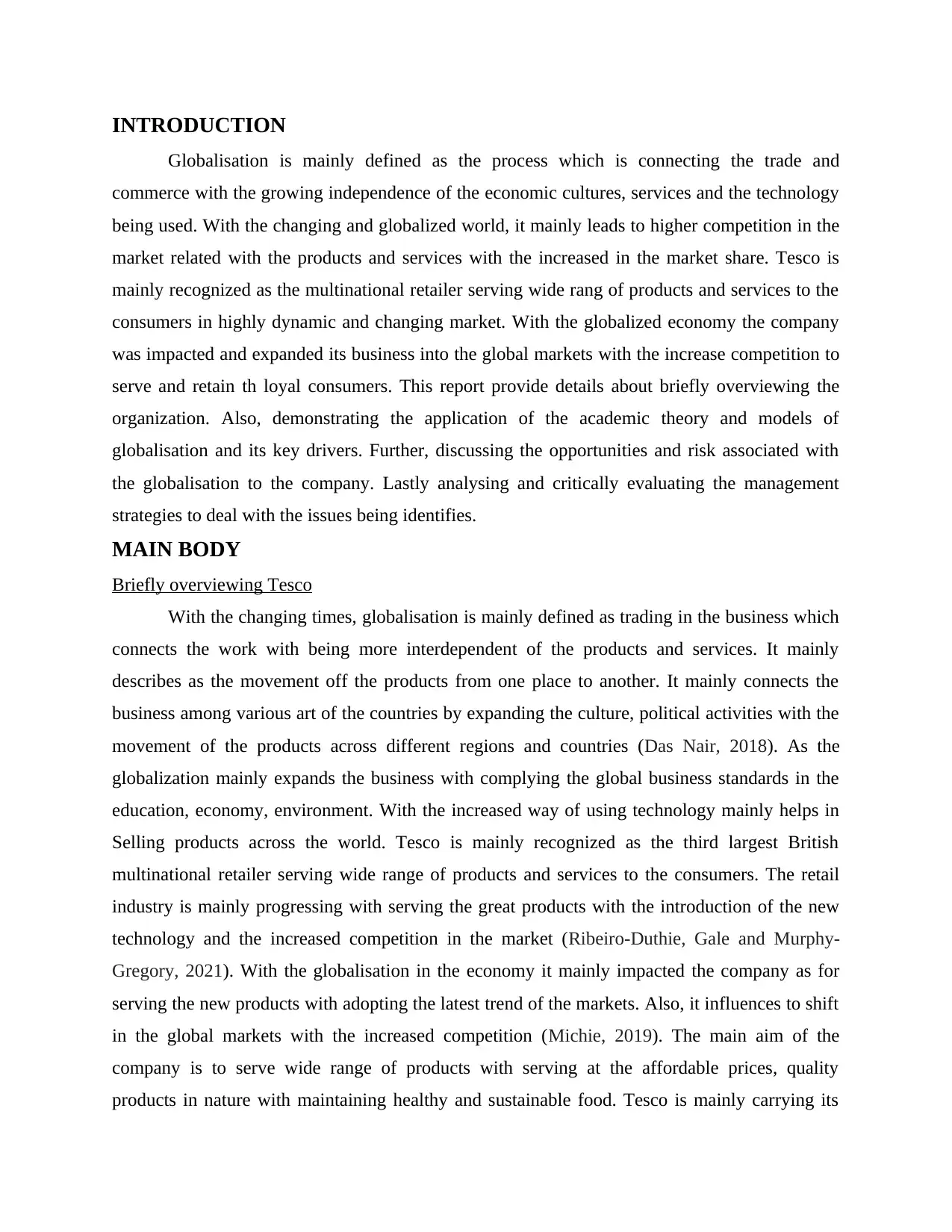
INTRODUCTION
Globalisation is mainly defined as the process which is connecting the trade and
commerce with the growing independence of the economic cultures, services and the technology
being used. With the changing and globalized world, it mainly leads to higher competition in the
market related with the products and services with the increased in the market share. Tesco is
mainly recognized as the multinational retailer serving wide rang of products and services to the
consumers in highly dynamic and changing market. With the globalized economy the company
was impacted and expanded its business into the global markets with the increase competition to
serve and retain th loyal consumers. This report provide details about briefly overviewing the
organization. Also, demonstrating the application of the academic theory and models of
globalisation and its key drivers. Further, discussing the opportunities and risk associated with
the globalisation to the company. Lastly analysing and critically evaluating the management
strategies to deal with the issues being identifies.
MAIN BODY
Briefly overviewing Tesco
With the changing times, globalisation is mainly defined as trading in the business which
connects the work with being more interdependent of the products and services. It mainly
describes as the movement off the products from one place to another. It mainly connects the
business among various art of the countries by expanding the culture, political activities with the
movement of the products across different regions and countries (Das Nair, 2018). As the
globalization mainly expands the business with complying the global business standards in the
education, economy, environment. With the increased way of using technology mainly helps in
Selling products across the world. Tesco is mainly recognized as the third largest British
multinational retailer serving wide range of products and services to the consumers. The retail
industry is mainly progressing with serving the great products with the introduction of the new
technology and the increased competition in the market (Ribeiro-Duthie, Gale and Murphy-
Gregory, 2021). With the globalisation in the economy it mainly impacted the company as for
serving the new products with adopting the latest trend of the markets. Also, it influences to shift
in the global markets with the increased competition (Michie, 2019). The main aim of the
company is to serve wide range of products with serving at the affordable prices, quality
products in nature with maintaining healthy and sustainable food. Tesco is mainly carrying its
Globalisation is mainly defined as the process which is connecting the trade and
commerce with the growing independence of the economic cultures, services and the technology
being used. With the changing and globalized world, it mainly leads to higher competition in the
market related with the products and services with the increased in the market share. Tesco is
mainly recognized as the multinational retailer serving wide rang of products and services to the
consumers in highly dynamic and changing market. With the globalized economy the company
was impacted and expanded its business into the global markets with the increase competition to
serve and retain th loyal consumers. This report provide details about briefly overviewing the
organization. Also, demonstrating the application of the academic theory and models of
globalisation and its key drivers. Further, discussing the opportunities and risk associated with
the globalisation to the company. Lastly analysing and critically evaluating the management
strategies to deal with the issues being identifies.
MAIN BODY
Briefly overviewing Tesco
With the changing times, globalisation is mainly defined as trading in the business which
connects the work with being more interdependent of the products and services. It mainly
describes as the movement off the products from one place to another. It mainly connects the
business among various art of the countries by expanding the culture, political activities with the
movement of the products across different regions and countries (Das Nair, 2018). As the
globalization mainly expands the business with complying the global business standards in the
education, economy, environment. With the increased way of using technology mainly helps in
Selling products across the world. Tesco is mainly recognized as the third largest British
multinational retailer serving wide range of products and services to the consumers. The retail
industry is mainly progressing with serving the great products with the introduction of the new
technology and the increased competition in the market (Ribeiro-Duthie, Gale and Murphy-
Gregory, 2021). With the globalisation in the economy it mainly impacted the company as for
serving the new products with adopting the latest trend of the markets. Also, it influences to shift
in the global markets with the increased competition (Michie, 2019). The main aim of the
company is to serve wide range of products with serving at the affordable prices, quality
products in nature with maintaining healthy and sustainable food. Tesco is mainly carrying its
Paraphrase This Document
Need a fresh take? Get an instant paraphrase of this document with our AI Paraphraser
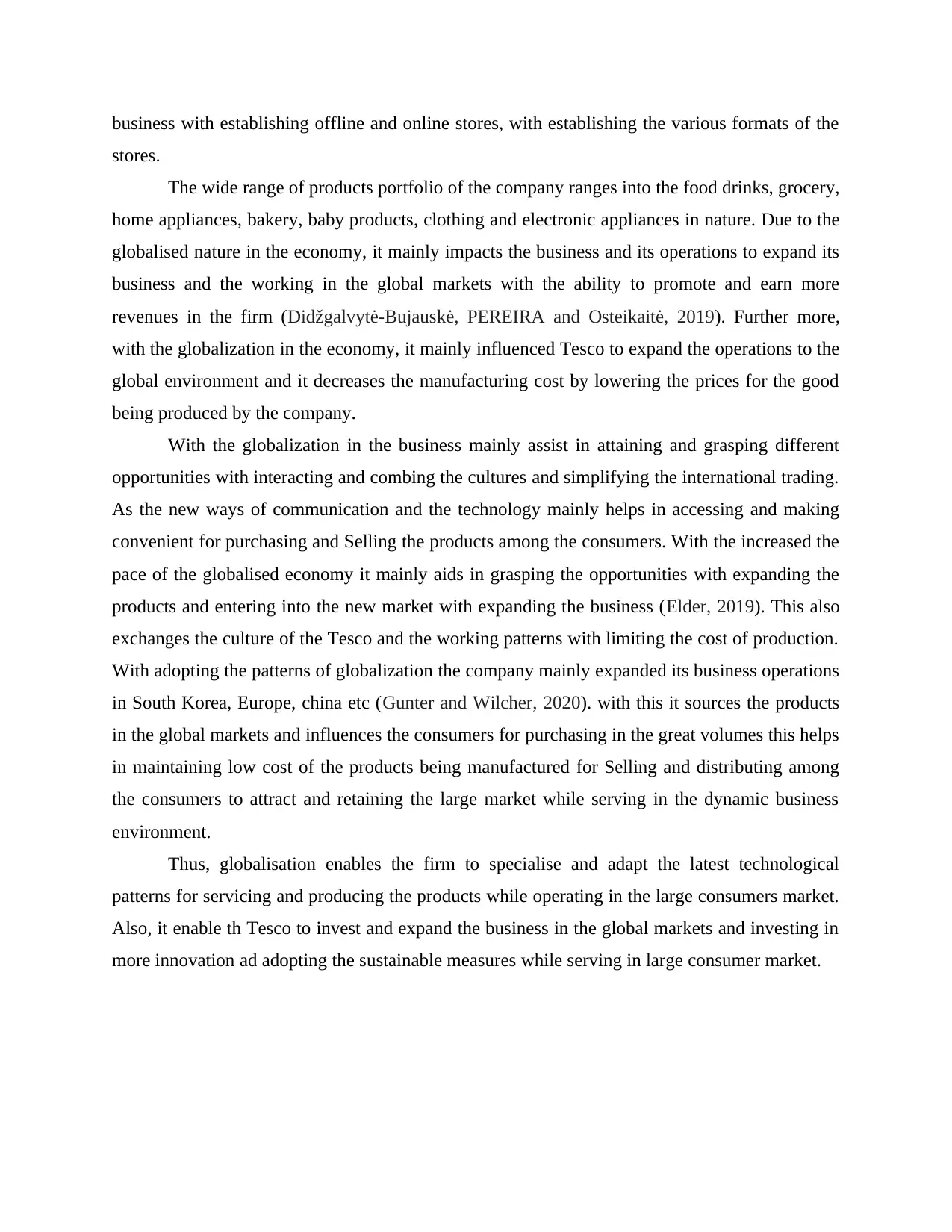
business with establishing offline and online stores, with establishing the various formats of the
stores.
The wide range of products portfolio of the company ranges into the food drinks, grocery,
home appliances, bakery, baby products, clothing and electronic appliances in nature. Due to the
globalised nature in the economy, it mainly impacts the business and its operations to expand its
business and the working in the global markets with the ability to promote and earn more
revenues in the firm (Didžgalvytė-Bujauskė, PEREIRA and Osteikaitė, 2019). Further more,
with the globalization in the economy, it mainly influenced Tesco to expand the operations to the
global environment and it decreases the manufacturing cost by lowering the prices for the good
being produced by the company.
With the globalization in the business mainly assist in attaining and grasping different
opportunities with interacting and combing the cultures and simplifying the international trading.
As the new ways of communication and the technology mainly helps in accessing and making
convenient for purchasing and Selling the products among the consumers. With the increased the
pace of the globalised economy it mainly aids in grasping the opportunities with expanding the
products and entering into the new market with expanding the business (Elder, 2019). This also
exchanges the culture of the Tesco and the working patterns with limiting the cost of production.
With adopting the patterns of globalization the company mainly expanded its business operations
in South Korea, Europe, china etc (Gunter and Wilcher, 2020). with this it sources the products
in the global markets and influences the consumers for purchasing in the great volumes this helps
in maintaining low cost of the products being manufactured for Selling and distributing among
the consumers to attract and retaining the large market while serving in the dynamic business
environment.
Thus, globalisation enables the firm to specialise and adapt the latest technological
patterns for servicing and producing the products while operating in the large consumers market.
Also, it enable th Tesco to invest and expand the business in the global markets and investing in
more innovation ad adopting the sustainable measures while serving in large consumer market.
stores.
The wide range of products portfolio of the company ranges into the food drinks, grocery,
home appliances, bakery, baby products, clothing and electronic appliances in nature. Due to the
globalised nature in the economy, it mainly impacts the business and its operations to expand its
business and the working in the global markets with the ability to promote and earn more
revenues in the firm (Didžgalvytė-Bujauskė, PEREIRA and Osteikaitė, 2019). Further more,
with the globalization in the economy, it mainly influenced Tesco to expand the operations to the
global environment and it decreases the manufacturing cost by lowering the prices for the good
being produced by the company.
With the globalization in the business mainly assist in attaining and grasping different
opportunities with interacting and combing the cultures and simplifying the international trading.
As the new ways of communication and the technology mainly helps in accessing and making
convenient for purchasing and Selling the products among the consumers. With the increased the
pace of the globalised economy it mainly aids in grasping the opportunities with expanding the
products and entering into the new market with expanding the business (Elder, 2019). This also
exchanges the culture of the Tesco and the working patterns with limiting the cost of production.
With adopting the patterns of globalization the company mainly expanded its business operations
in South Korea, Europe, china etc (Gunter and Wilcher, 2020). with this it sources the products
in the global markets and influences the consumers for purchasing in the great volumes this helps
in maintaining low cost of the products being manufactured for Selling and distributing among
the consumers to attract and retaining the large market while serving in the dynamic business
environment.
Thus, globalisation enables the firm to specialise and adapt the latest technological
patterns for servicing and producing the products while operating in the large consumers market.
Also, it enable th Tesco to invest and expand the business in the global markets and investing in
more innovation ad adopting the sustainable measures while serving in large consumer market.
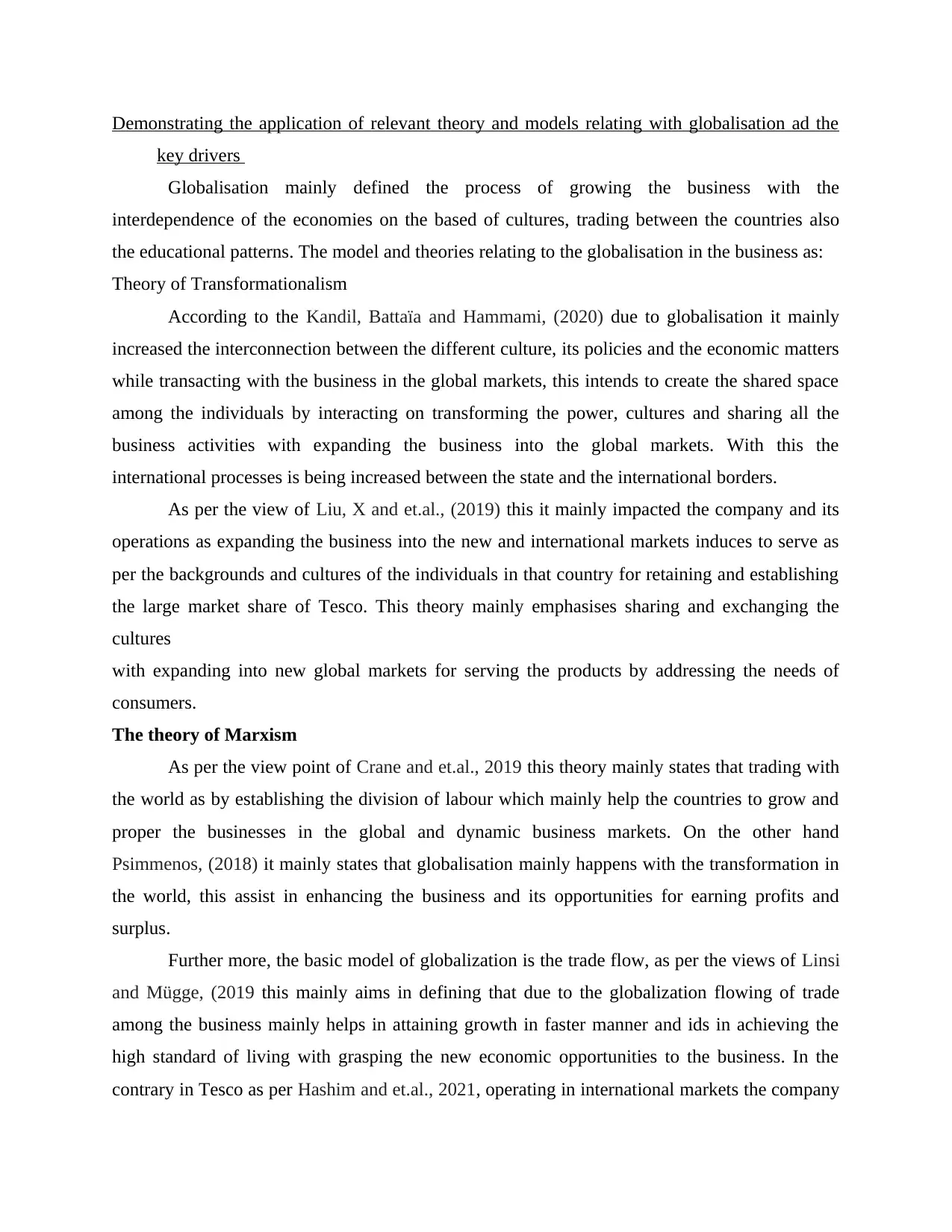
Demonstrating the application of relevant theory and models relating with globalisation ad the
key drivers
Globalisation mainly defined the process of growing the business with the
interdependence of the economies on the based of cultures, trading between the countries also
the educational patterns. The model and theories relating to the globalisation in the business as:
Theory of Transformationalism
According to the Kandil, Battaïa and Hammami, (2020) due to globalisation it mainly
increased the interconnection between the different culture, its policies and the economic matters
while transacting with the business in the global markets, this intends to create the shared space
among the individuals by interacting on transforming the power, cultures and sharing all the
business activities with expanding the business into the global markets. With this the
international processes is being increased between the state and the international borders.
As per the view of Liu, X and et.al., (2019) this it mainly impacted the company and its
operations as expanding the business into the new and international markets induces to serve as
per the backgrounds and cultures of the individuals in that country for retaining and establishing
the large market share of Tesco. This theory mainly emphasises sharing and exchanging the
cultures
with expanding into new global markets for serving the products by addressing the needs of
consumers.
The theory of Marxism
As per the view point of Crane and et.al., 2019 this theory mainly states that trading with
the world as by establishing the division of labour which mainly help the countries to grow and
proper the businesses in the global and dynamic business markets. On the other hand
Psimmenos, (2018) it mainly states that globalisation mainly happens with the transformation in
the world, this assist in enhancing the business and its opportunities for earning profits and
surplus.
Further more, the basic model of globalization is the trade flow, as per the views of Linsi
and Mügge, (2019 this mainly aims in defining that due to the globalization flowing of trade
among the business mainly helps in attaining growth in faster manner and ids in achieving the
high standard of living with grasping the new economic opportunities to the business. In the
contrary in Tesco as per Hashim and et.al., 2021, operating in international markets the company
key drivers
Globalisation mainly defined the process of growing the business with the
interdependence of the economies on the based of cultures, trading between the countries also
the educational patterns. The model and theories relating to the globalisation in the business as:
Theory of Transformationalism
According to the Kandil, Battaïa and Hammami, (2020) due to globalisation it mainly
increased the interconnection between the different culture, its policies and the economic matters
while transacting with the business in the global markets, this intends to create the shared space
among the individuals by interacting on transforming the power, cultures and sharing all the
business activities with expanding the business into the global markets. With this the
international processes is being increased between the state and the international borders.
As per the view of Liu, X and et.al., (2019) this it mainly impacted the company and its
operations as expanding the business into the new and international markets induces to serve as
per the backgrounds and cultures of the individuals in that country for retaining and establishing
the large market share of Tesco. This theory mainly emphasises sharing and exchanging the
cultures
with expanding into new global markets for serving the products by addressing the needs of
consumers.
The theory of Marxism
As per the view point of Crane and et.al., 2019 this theory mainly states that trading with
the world as by establishing the division of labour which mainly help the countries to grow and
proper the businesses in the global and dynamic business markets. On the other hand
Psimmenos, (2018) it mainly states that globalisation mainly happens with the transformation in
the world, this assist in enhancing the business and its opportunities for earning profits and
surplus.
Further more, the basic model of globalization is the trade flow, as per the views of Linsi
and Mügge, (2019 this mainly aims in defining that due to the globalization flowing of trade
among the business mainly helps in attaining growth in faster manner and ids in achieving the
high standard of living with grasping the new economic opportunities to the business. In the
contrary in Tesco as per Hashim and et.al., 2021, operating in international markets the company
⊘ This is a preview!⊘
Do you want full access?
Subscribe today to unlock all pages.

Trusted by 1+ million students worldwide
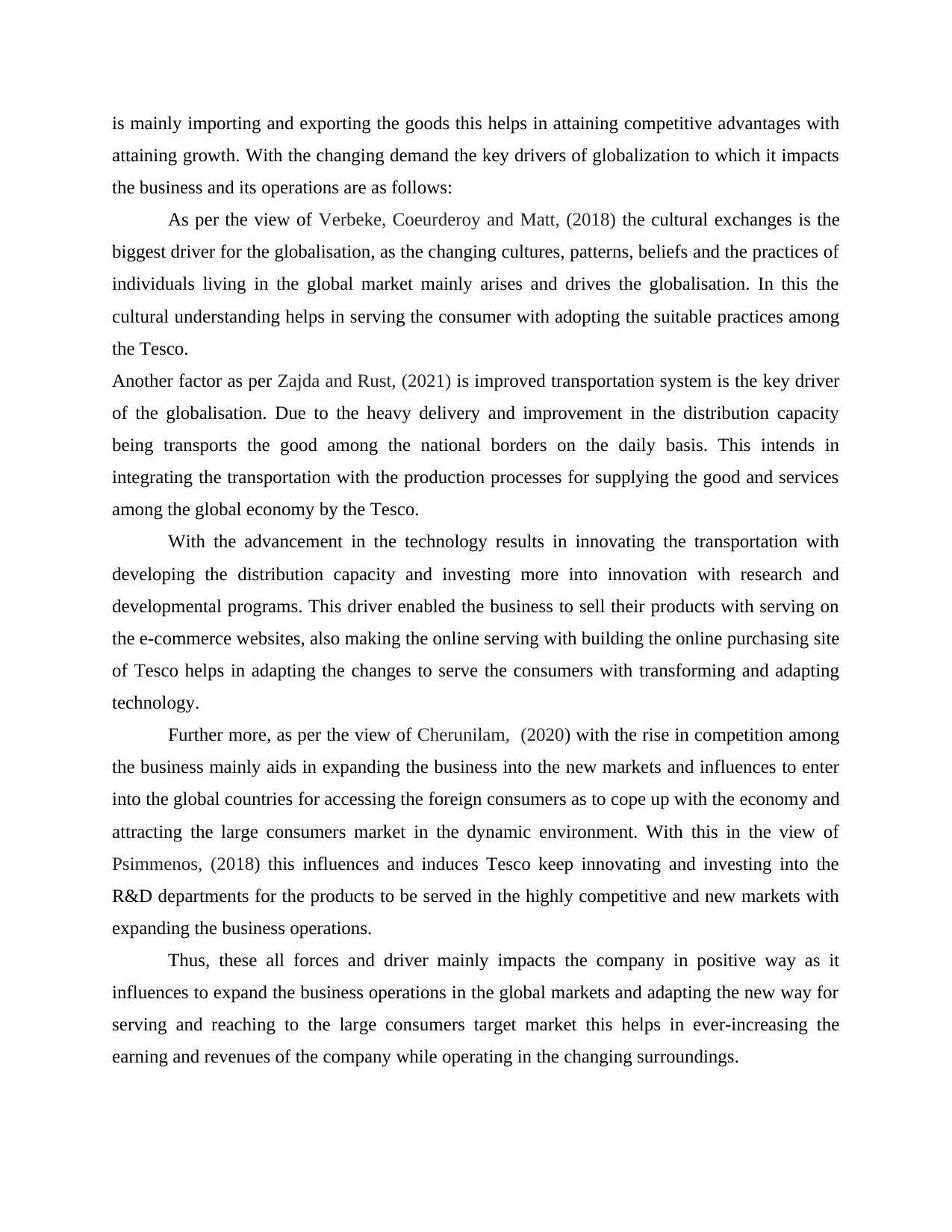
is mainly importing and exporting the goods this helps in attaining competitive advantages with
attaining growth. With the changing demand the key drivers of globalization to which it impacts
the business and its operations are as follows:
As per the view of Verbeke, Coeurderoy and Matt, (2018) the cultural exchanges is the
biggest driver for the globalisation, as the changing cultures, patterns, beliefs and the practices of
individuals living in the global market mainly arises and drives the globalisation. In this the
cultural understanding helps in serving the consumer with adopting the suitable practices among
the Tesco.
Another factor as per Zajda and Rust, (2021) is improved transportation system is the key driver
of the globalisation. Due to the heavy delivery and improvement in the distribution capacity
being transports the good among the national borders on the daily basis. This intends in
integrating the transportation with the production processes for supplying the good and services
among the global economy by the Tesco.
With the advancement in the technology results in innovating the transportation with
developing the distribution capacity and investing more into innovation with research and
developmental programs. This driver enabled the business to sell their products with serving on
the e-commerce websites, also making the online serving with building the online purchasing site
of Tesco helps in adapting the changes to serve the consumers with transforming and adapting
technology.
Further more, as per the view of Cherunilam, (2020) with the rise in competition among
the business mainly aids in expanding the business into the new markets and influences to enter
into the global countries for accessing the foreign consumers as to cope up with the economy and
attracting the large consumers market in the dynamic environment. With this in the view of
Psimmenos, (2018) this influences and induces Tesco keep innovating and investing into the
R&D departments for the products to be served in the highly competitive and new markets with
expanding the business operations.
Thus, these all forces and driver mainly impacts the company in positive way as it
influences to expand the business operations in the global markets and adapting the new way for
serving and reaching to the large consumers target market this helps in ever-increasing the
earning and revenues of the company while operating in the changing surroundings.
attaining growth. With the changing demand the key drivers of globalization to which it impacts
the business and its operations are as follows:
As per the view of Verbeke, Coeurderoy and Matt, (2018) the cultural exchanges is the
biggest driver for the globalisation, as the changing cultures, patterns, beliefs and the practices of
individuals living in the global market mainly arises and drives the globalisation. In this the
cultural understanding helps in serving the consumer with adopting the suitable practices among
the Tesco.
Another factor as per Zajda and Rust, (2021) is improved transportation system is the key driver
of the globalisation. Due to the heavy delivery and improvement in the distribution capacity
being transports the good among the national borders on the daily basis. This intends in
integrating the transportation with the production processes for supplying the good and services
among the global economy by the Tesco.
With the advancement in the technology results in innovating the transportation with
developing the distribution capacity and investing more into innovation with research and
developmental programs. This driver enabled the business to sell their products with serving on
the e-commerce websites, also making the online serving with building the online purchasing site
of Tesco helps in adapting the changes to serve the consumers with transforming and adapting
technology.
Further more, as per the view of Cherunilam, (2020) with the rise in competition among
the business mainly aids in expanding the business into the new markets and influences to enter
into the global countries for accessing the foreign consumers as to cope up with the economy and
attracting the large consumers market in the dynamic environment. With this in the view of
Psimmenos, (2018) this influences and induces Tesco keep innovating and investing into the
R&D departments for the products to be served in the highly competitive and new markets with
expanding the business operations.
Thus, these all forces and driver mainly impacts the company in positive way as it
influences to expand the business operations in the global markets and adapting the new way for
serving and reaching to the large consumers target market this helps in ever-increasing the
earning and revenues of the company while operating in the changing surroundings.
Paraphrase This Document
Need a fresh take? Get an instant paraphrase of this document with our AI Paraphraser
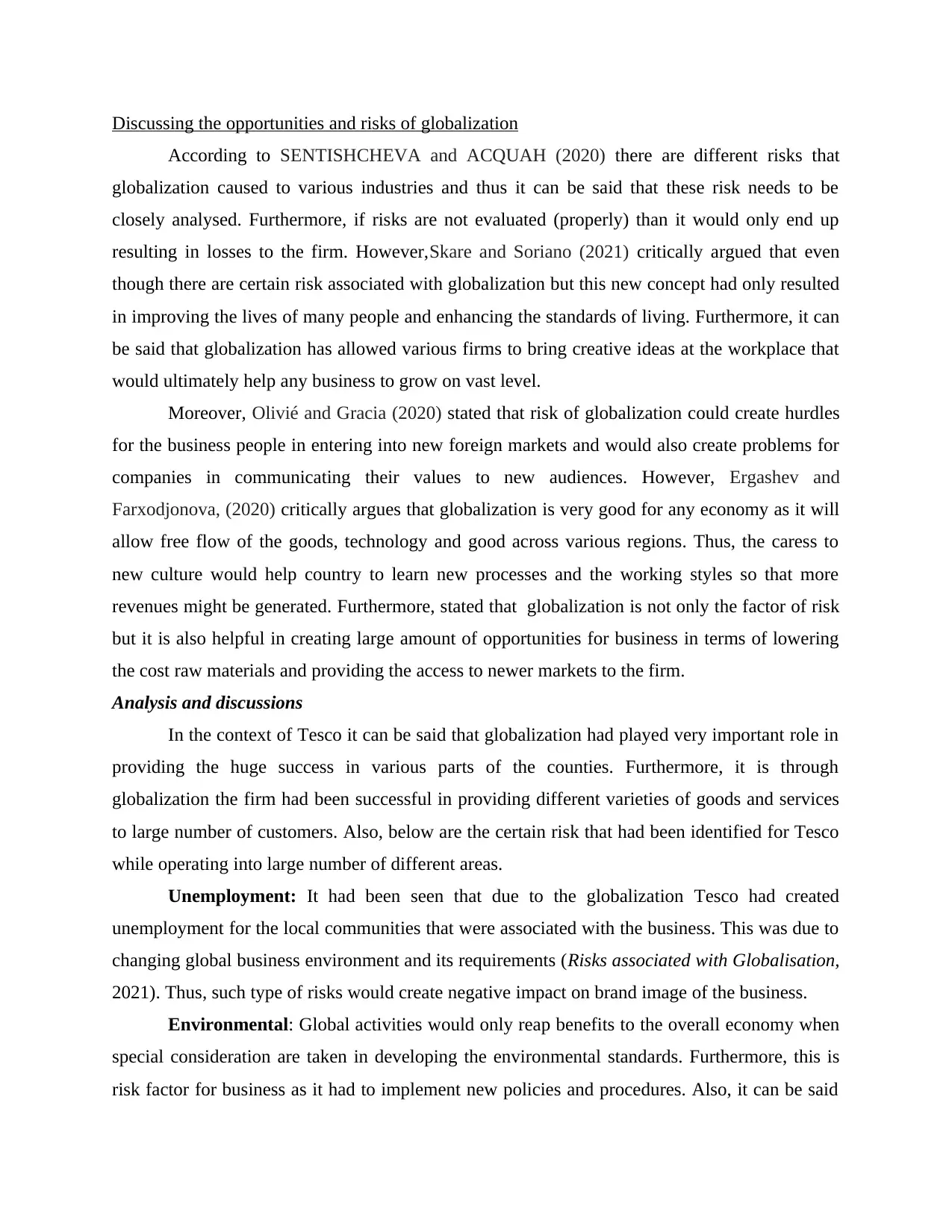
Discussing the opportunities and risks of globalization
According to SENTISHCHEVA and ACQUAH (2020) there are different risks that
globalization caused to various industries and thus it can be said that these risk needs to be
closely analysed. Furthermore, if risks are not evaluated (properly) than it would only end up
resulting in losses to the firm. However,Skare and Soriano (2021) critically argued that even
though there are certain risk associated with globalization but this new concept had only resulted
in improving the lives of many people and enhancing the standards of living. Furthermore, it can
be said that globalization has allowed various firms to bring creative ideas at the workplace that
would ultimately help any business to grow on vast level.
Moreover, Olivié and Gracia (2020) stated that risk of globalization could create hurdles
for the business people in entering into new foreign markets and would also create problems for
companies in communicating their values to new audiences. However, Ergashev and
Farxodjonova, (2020) critically argues that globalization is very good for any economy as it will
allow free flow of the goods, technology and good across various regions. Thus, the caress to
new culture would help country to learn new processes and the working styles so that more
revenues might be generated. Furthermore, stated that globalization is not only the factor of risk
but it is also helpful in creating large amount of opportunities for business in terms of lowering
the cost raw materials and providing the access to newer markets to the firm.
Analysis and discussions
In the context of Tesco it can be said that globalization had played very important role in
providing the huge success in various parts of the counties. Furthermore, it is through
globalization the firm had been successful in providing different varieties of goods and services
to large number of customers. Also, below are the certain risk that had been identified for Tesco
while operating into large number of different areas.
Unemployment: It had been seen that due to the globalization Tesco had created
unemployment for the local communities that were associated with the business. This was due to
changing global business environment and its requirements (Risks associated with Globalisation,
2021). Thus, such type of risks would create negative impact on brand image of the business.
Environmental: Global activities would only reap benefits to the overall economy when
special consideration are taken in developing the environmental standards. Furthermore, this is
risk factor for business as it had to implement new policies and procedures. Also, it can be said
According to SENTISHCHEVA and ACQUAH (2020) there are different risks that
globalization caused to various industries and thus it can be said that these risk needs to be
closely analysed. Furthermore, if risks are not evaluated (properly) than it would only end up
resulting in losses to the firm. However,Skare and Soriano (2021) critically argued that even
though there are certain risk associated with globalization but this new concept had only resulted
in improving the lives of many people and enhancing the standards of living. Furthermore, it can
be said that globalization has allowed various firms to bring creative ideas at the workplace that
would ultimately help any business to grow on vast level.
Moreover, Olivié and Gracia (2020) stated that risk of globalization could create hurdles
for the business people in entering into new foreign markets and would also create problems for
companies in communicating their values to new audiences. However, Ergashev and
Farxodjonova, (2020) critically argues that globalization is very good for any economy as it will
allow free flow of the goods, technology and good across various regions. Thus, the caress to
new culture would help country to learn new processes and the working styles so that more
revenues might be generated. Furthermore, stated that globalization is not only the factor of risk
but it is also helpful in creating large amount of opportunities for business in terms of lowering
the cost raw materials and providing the access to newer markets to the firm.
Analysis and discussions
In the context of Tesco it can be said that globalization had played very important role in
providing the huge success in various parts of the counties. Furthermore, it is through
globalization the firm had been successful in providing different varieties of goods and services
to large number of customers. Also, below are the certain risk that had been identified for Tesco
while operating into large number of different areas.
Unemployment: It had been seen that due to the globalization Tesco had created
unemployment for the local communities that were associated with the business. This was due to
changing global business environment and its requirements (Risks associated with Globalisation,
2021). Thus, such type of risks would create negative impact on brand image of the business.
Environmental: Global activities would only reap benefits to the overall economy when
special consideration are taken in developing the environmental standards. Furthermore, this is
risk factor for business as it had to implement new policies and procedures. Also, it can be said
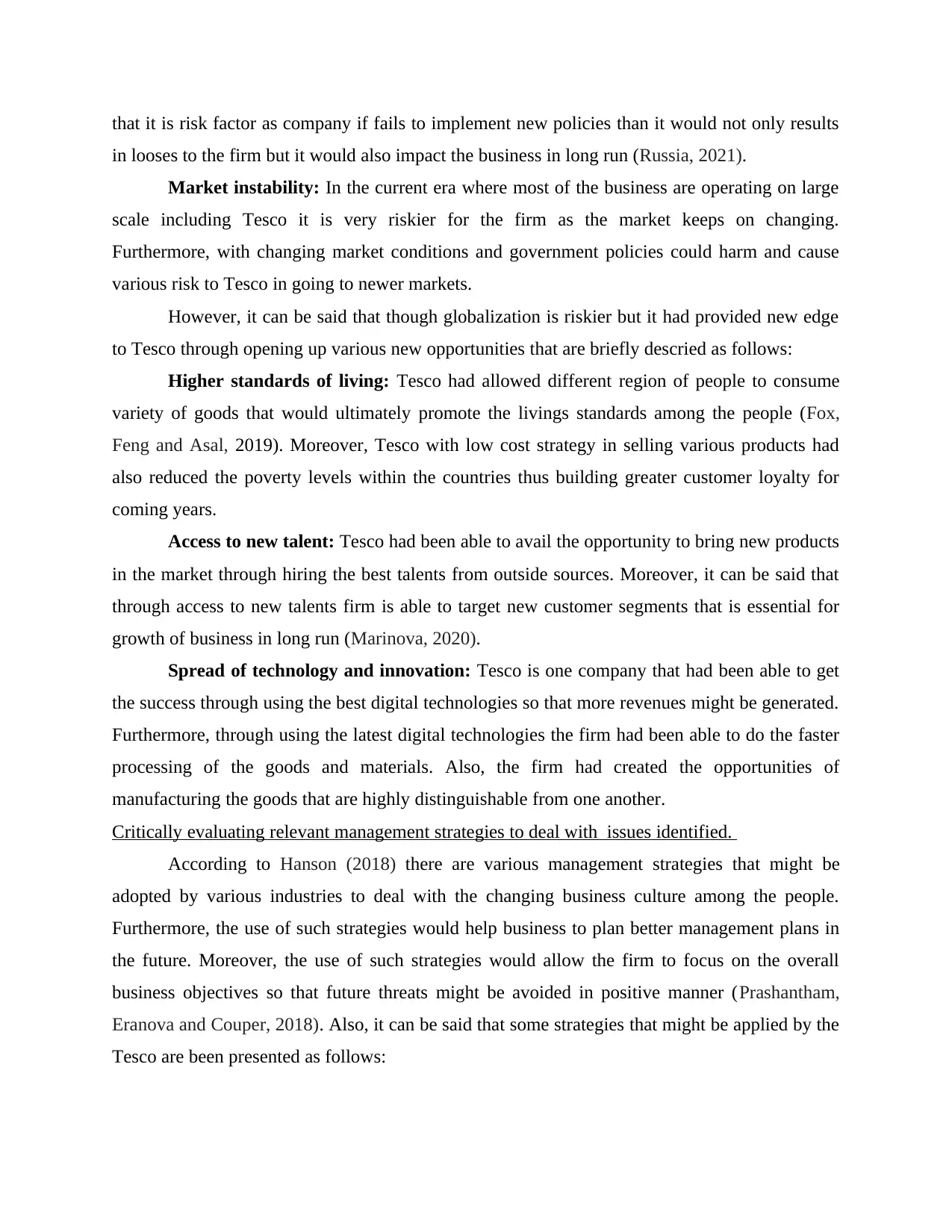
that it is risk factor as company if fails to implement new policies than it would not only results
in looses to the firm but it would also impact the business in long run (Russia, 2021).
Market instability: In the current era where most of the business are operating on large
scale including Tesco it is very riskier for the firm as the market keeps on changing.
Furthermore, with changing market conditions and government policies could harm and cause
various risk to Tesco in going to newer markets.
However, it can be said that though globalization is riskier but it had provided new edge
to Tesco through opening up various new opportunities that are briefly descried as follows:
Higher standards of living: Tesco had allowed different region of people to consume
variety of goods that would ultimately promote the livings standards among the people (Fox,
Feng and Asal, 2019). Moreover, Tesco with low cost strategy in selling various products had
also reduced the poverty levels within the countries thus building greater customer loyalty for
coming years.
Access to new talent: Tesco had been able to avail the opportunity to bring new products
in the market through hiring the best talents from outside sources. Moreover, it can be said that
through access to new talents firm is able to target new customer segments that is essential for
growth of business in long run (Marinova, 2020).
Spread of technology and innovation: Tesco is one company that had been able to get
the success through using the best digital technologies so that more revenues might be generated.
Furthermore, through using the latest digital technologies the firm had been able to do the faster
processing of the goods and materials. Also, the firm had created the opportunities of
manufacturing the goods that are highly distinguishable from one another.
Critically evaluating relevant management strategies to deal with issues identified.
According to Hanson (2018) there are various management strategies that might be
adopted by various industries to deal with the changing business culture among the people.
Furthermore, the use of such strategies would help business to plan better management plans in
the future. Moreover, the use of such strategies would allow the firm to focus on the overall
business objectives so that future threats might be avoided in positive manner (Prashantham,
Eranova and Couper, 2018). Also, it can be said that some strategies that might be applied by the
Tesco are been presented as follows:
in looses to the firm but it would also impact the business in long run (Russia, 2021).
Market instability: In the current era where most of the business are operating on large
scale including Tesco it is very riskier for the firm as the market keeps on changing.
Furthermore, with changing market conditions and government policies could harm and cause
various risk to Tesco in going to newer markets.
However, it can be said that though globalization is riskier but it had provided new edge
to Tesco through opening up various new opportunities that are briefly descried as follows:
Higher standards of living: Tesco had allowed different region of people to consume
variety of goods that would ultimately promote the livings standards among the people (Fox,
Feng and Asal, 2019). Moreover, Tesco with low cost strategy in selling various products had
also reduced the poverty levels within the countries thus building greater customer loyalty for
coming years.
Access to new talent: Tesco had been able to avail the opportunity to bring new products
in the market through hiring the best talents from outside sources. Moreover, it can be said that
through access to new talents firm is able to target new customer segments that is essential for
growth of business in long run (Marinova, 2020).
Spread of technology and innovation: Tesco is one company that had been able to get
the success through using the best digital technologies so that more revenues might be generated.
Furthermore, through using the latest digital technologies the firm had been able to do the faster
processing of the goods and materials. Also, the firm had created the opportunities of
manufacturing the goods that are highly distinguishable from one another.
Critically evaluating relevant management strategies to deal with issues identified.
According to Hanson (2018) there are various management strategies that might be
adopted by various industries to deal with the changing business culture among the people.
Furthermore, the use of such strategies would help business to plan better management plans in
the future. Moreover, the use of such strategies would allow the firm to focus on the overall
business objectives so that future threats might be avoided in positive manner (Prashantham,
Eranova and Couper, 2018). Also, it can be said that some strategies that might be applied by the
Tesco are been presented as follows:
⊘ This is a preview!⊘
Do you want full access?
Subscribe today to unlock all pages.

Trusted by 1+ million students worldwide
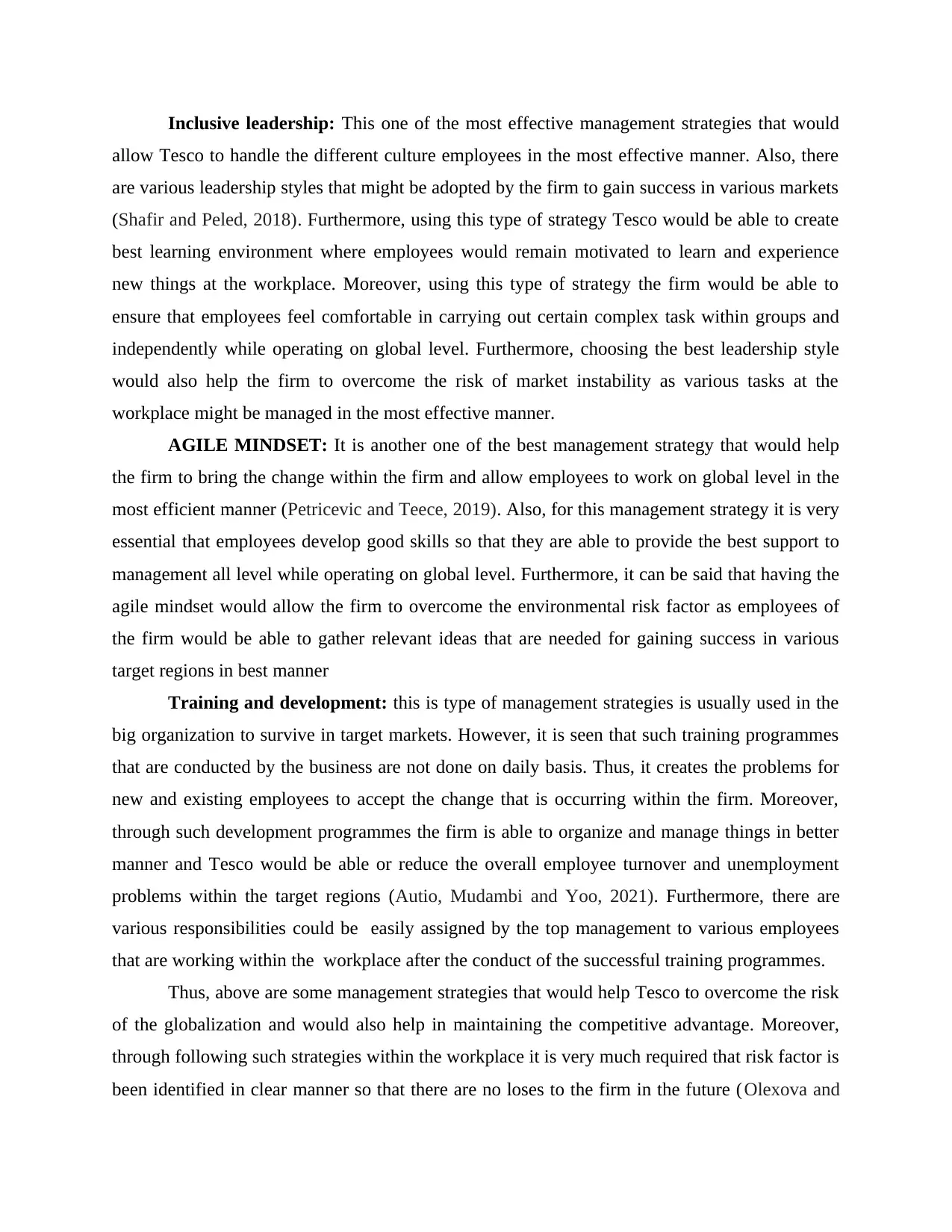
Inclusive leadership: This one of the most effective management strategies that would
allow Tesco to handle the different culture employees in the most effective manner. Also, there
are various leadership styles that might be adopted by the firm to gain success in various markets
(Shafir and Peled, 2018). Furthermore, using this type of strategy Tesco would be able to create
best learning environment where employees would remain motivated to learn and experience
new things at the workplace. Moreover, using this type of strategy the firm would be able to
ensure that employees feel comfortable in carrying out certain complex task within groups and
independently while operating on global level. Furthermore, choosing the best leadership style
would also help the firm to overcome the risk of market instability as various tasks at the
workplace might be managed in the most effective manner.
AGILE MINDSET: It is another one of the best management strategy that would help
the firm to bring the change within the firm and allow employees to work on global level in the
most efficient manner (Petricevic and Teece, 2019). Also, for this management strategy it is very
essential that employees develop good skills so that they are able to provide the best support to
management all level while operating on global level. Furthermore, it can be said that having the
agile mindset would allow the firm to overcome the environmental risk factor as employees of
the firm would be able to gather relevant ideas that are needed for gaining success in various
target regions in best manner
Training and development: this is type of management strategies is usually used in the
big organization to survive in target markets. However, it is seen that such training programmes
that are conducted by the business are not done on daily basis. Thus, it creates the problems for
new and existing employees to accept the change that is occurring within the firm. Moreover,
through such development programmes the firm is able to organize and manage things in better
manner and Tesco would be able or reduce the overall employee turnover and unemployment
problems within the target regions (Autio, Mudambi and Yoo, 2021). Furthermore, there are
various responsibilities could be easily assigned by the top management to various employees
that are working within the workplace after the conduct of the successful training programmes.
Thus, above are some management strategies that would help Tesco to overcome the risk
of the globalization and would also help in maintaining the competitive advantage. Moreover,
through following such strategies within the workplace it is very much required that risk factor is
been identified in clear manner so that there are no loses to the firm in the future (Olexova and
allow Tesco to handle the different culture employees in the most effective manner. Also, there
are various leadership styles that might be adopted by the firm to gain success in various markets
(Shafir and Peled, 2018). Furthermore, using this type of strategy Tesco would be able to create
best learning environment where employees would remain motivated to learn and experience
new things at the workplace. Moreover, using this type of strategy the firm would be able to
ensure that employees feel comfortable in carrying out certain complex task within groups and
independently while operating on global level. Furthermore, choosing the best leadership style
would also help the firm to overcome the risk of market instability as various tasks at the
workplace might be managed in the most effective manner.
AGILE MINDSET: It is another one of the best management strategy that would help
the firm to bring the change within the firm and allow employees to work on global level in the
most efficient manner (Petricevic and Teece, 2019). Also, for this management strategy it is very
essential that employees develop good skills so that they are able to provide the best support to
management all level while operating on global level. Furthermore, it can be said that having the
agile mindset would allow the firm to overcome the environmental risk factor as employees of
the firm would be able to gather relevant ideas that are needed for gaining success in various
target regions in best manner
Training and development: this is type of management strategies is usually used in the
big organization to survive in target markets. However, it is seen that such training programmes
that are conducted by the business are not done on daily basis. Thus, it creates the problems for
new and existing employees to accept the change that is occurring within the firm. Moreover,
through such development programmes the firm is able to organize and manage things in better
manner and Tesco would be able or reduce the overall employee turnover and unemployment
problems within the target regions (Autio, Mudambi and Yoo, 2021). Furthermore, there are
various responsibilities could be easily assigned by the top management to various employees
that are working within the workplace after the conduct of the successful training programmes.
Thus, above are some management strategies that would help Tesco to overcome the risk
of the globalization and would also help in maintaining the competitive advantage. Moreover,
through following such strategies within the workplace it is very much required that risk factor is
been identified in clear manner so that there are no loses to the firm in the future (Olexova and
Paraphrase This Document
Need a fresh take? Get an instant paraphrase of this document with our AI Paraphraser
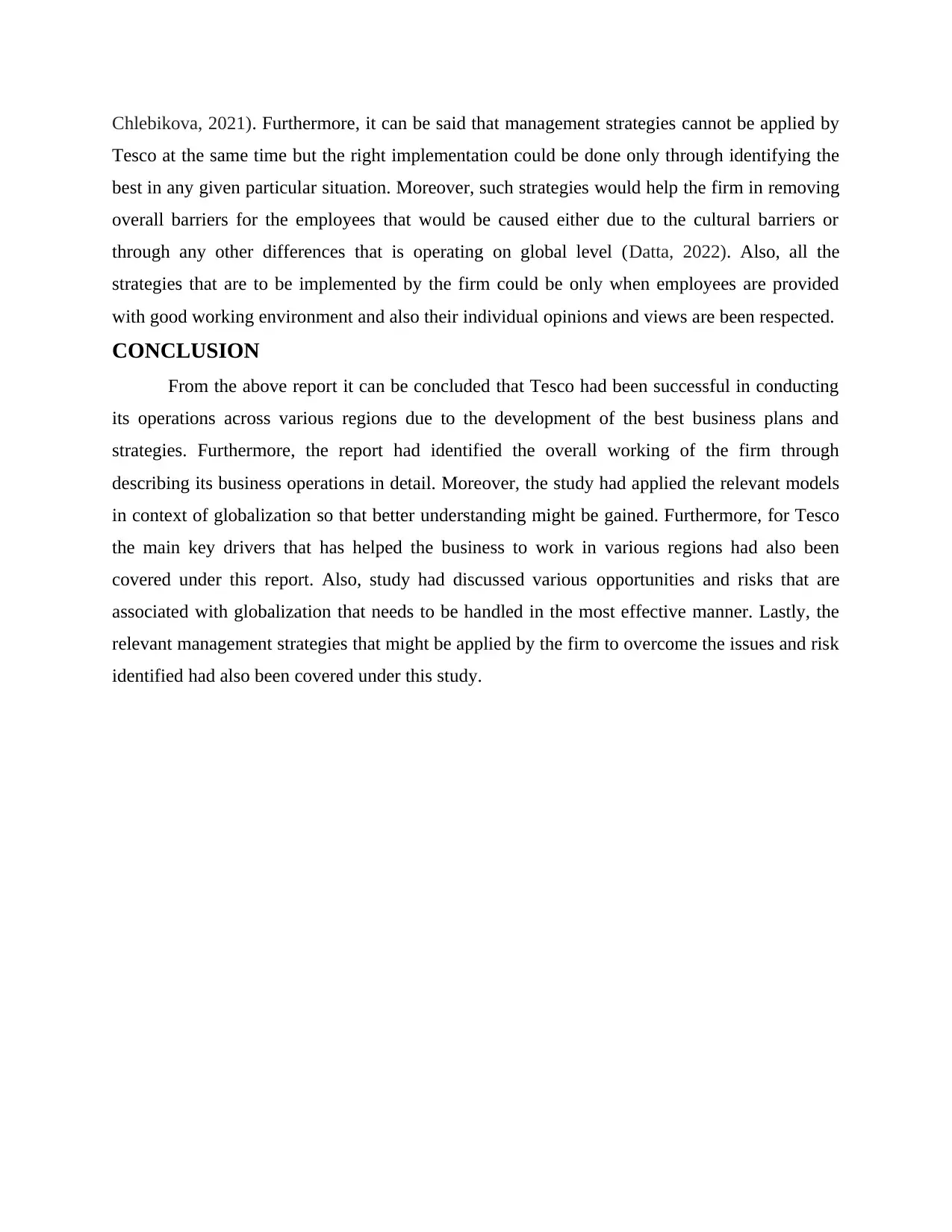
Chlebikova, 2021). Furthermore, it can be said that management strategies cannot be applied by
Tesco at the same time but the right implementation could be done only through identifying the
best in any given particular situation. Moreover, such strategies would help the firm in removing
overall barriers for the employees that would be caused either due to the cultural barriers or
through any other differences that is operating on global level (Datta, 2022). Also, all the
strategies that are to be implemented by the firm could be only when employees are provided
with good working environment and also their individual opinions and views are been respected.
CONCLUSION
From the above report it can be concluded that Tesco had been successful in conducting
its operations across various regions due to the development of the best business plans and
strategies. Furthermore, the report had identified the overall working of the firm through
describing its business operations in detail. Moreover, the study had applied the relevant models
in context of globalization so that better understanding might be gained. Furthermore, for Tesco
the main key drivers that has helped the business to work in various regions had also been
covered under this report. Also, study had discussed various opportunities and risks that are
associated with globalization that needs to be handled in the most effective manner. Lastly, the
relevant management strategies that might be applied by the firm to overcome the issues and risk
identified had also been covered under this study.
Tesco at the same time but the right implementation could be done only through identifying the
best in any given particular situation. Moreover, such strategies would help the firm in removing
overall barriers for the employees that would be caused either due to the cultural barriers or
through any other differences that is operating on global level (Datta, 2022). Also, all the
strategies that are to be implemented by the firm could be only when employees are provided
with good working environment and also their individual opinions and views are been respected.
CONCLUSION
From the above report it can be concluded that Tesco had been successful in conducting
its operations across various regions due to the development of the best business plans and
strategies. Furthermore, the report had identified the overall working of the firm through
describing its business operations in detail. Moreover, the study had applied the relevant models
in context of globalization so that better understanding might be gained. Furthermore, for Tesco
the main key drivers that has helped the business to work in various regions had also been
covered under this report. Also, study had discussed various opportunities and risks that are
associated with globalization that needs to be handled in the most effective manner. Lastly, the
relevant management strategies that might be applied by the firm to overcome the issues and risk
identified had also been covered under this study.
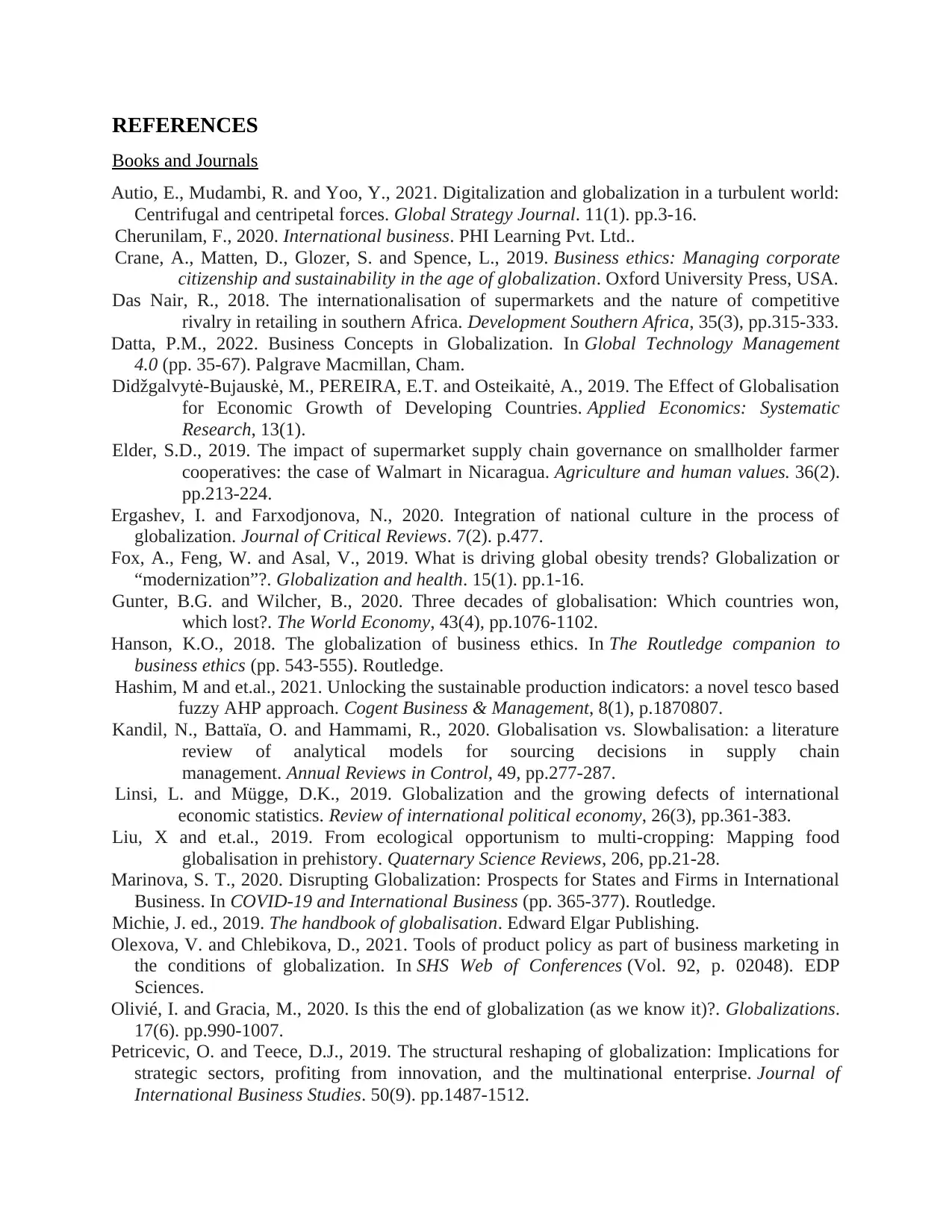
REFERENCES
Books and Journals
Autio, E., Mudambi, R. and Yoo, Y., 2021. Digitalization and globalization in a turbulent world:
Centrifugal and centripetal forces. Global Strategy Journal. 11(1). pp.3-16.
Cherunilam, F., 2020. International business. PHI Learning Pvt. Ltd..
Crane, A., Matten, D., Glozer, S. and Spence, L., 2019. Business ethics: Managing corporate
citizenship and sustainability in the age of globalization. Oxford University Press, USA.
Das Nair, R., 2018. The internationalisation of supermarkets and the nature of competitive
rivalry in retailing in southern Africa. Development Southern Africa, 35(3), pp.315-333.
Datta, P.M., 2022. Business Concepts in Globalization. In Global Technology Management
4.0 (pp. 35-67). Palgrave Macmillan, Cham.
Didžgalvytė-Bujauskė, M., PEREIRA, E.T. and Osteikaitė, A., 2019. The Effect of Globalisation
for Economic Growth of Developing Countries. Applied Economics: Systematic
Research, 13(1).
Elder, S.D., 2019. The impact of supermarket supply chain governance on smallholder farmer
cooperatives: the case of Walmart in Nicaragua. Agriculture and human values. 36(2).
pp.213-224.
Ergashev, I. and Farxodjonova, N., 2020. Integration of national culture in the process of
globalization. Journal of Critical Reviews. 7(2). p.477.
Fox, A., Feng, W. and Asal, V., 2019. What is driving global obesity trends? Globalization or
“modernization”?. Globalization and health. 15(1). pp.1-16.
Gunter, B.G. and Wilcher, B., 2020. Three decades of globalisation: Which countries won,
which lost?. The World Economy, 43(4), pp.1076-1102.
Hanson, K.O., 2018. The globalization of business ethics. In The Routledge companion to
business ethics (pp. 543-555). Routledge.
Hashim, M and et.al., 2021. Unlocking the sustainable production indicators: a novel tesco based
fuzzy AHP approach. Cogent Business & Management, 8(1), p.1870807.
Kandil, N., Battaïa, O. and Hammami, R., 2020. Globalisation vs. Slowbalisation: a literature
review of analytical models for sourcing decisions in supply chain
management. Annual Reviews in Control, 49, pp.277-287.
Linsi, L. and Mügge, D.K., 2019. Globalization and the growing defects of international
economic statistics. Review of international political economy, 26(3), pp.361-383.
Liu, X and et.al., 2019. From ecological opportunism to multi-cropping: Mapping food
globalisation in prehistory. Quaternary Science Reviews, 206, pp.21-28.
Marinova, S. T., 2020. Disrupting Globalization: Prospects for States and Firms in International
Business. In COVID-19 and International Business (pp. 365-377). Routledge.
Michie, J. ed., 2019. The handbook of globalisation. Edward Elgar Publishing.
Olexova, V. and Chlebikova, D., 2021. Tools of product policy as part of business marketing in
the conditions of globalization. In SHS Web of Conferences (Vol. 92, p. 02048). EDP
Sciences.
Olivié, I. and Gracia, M., 2020. Is this the end of globalization (as we know it)?. Globalizations.
17(6). pp.990-1007.
Petricevic, O. and Teece, D.J., 2019. The structural reshaping of globalization: Implications for
strategic sectors, profiting from innovation, and the multinational enterprise. Journal of
International Business Studies. 50(9). pp.1487-1512.
Books and Journals
Autio, E., Mudambi, R. and Yoo, Y., 2021. Digitalization and globalization in a turbulent world:
Centrifugal and centripetal forces. Global Strategy Journal. 11(1). pp.3-16.
Cherunilam, F., 2020. International business. PHI Learning Pvt. Ltd..
Crane, A., Matten, D., Glozer, S. and Spence, L., 2019. Business ethics: Managing corporate
citizenship and sustainability in the age of globalization. Oxford University Press, USA.
Das Nair, R., 2018. The internationalisation of supermarkets and the nature of competitive
rivalry in retailing in southern Africa. Development Southern Africa, 35(3), pp.315-333.
Datta, P.M., 2022. Business Concepts in Globalization. In Global Technology Management
4.0 (pp. 35-67). Palgrave Macmillan, Cham.
Didžgalvytė-Bujauskė, M., PEREIRA, E.T. and Osteikaitė, A., 2019. The Effect of Globalisation
for Economic Growth of Developing Countries. Applied Economics: Systematic
Research, 13(1).
Elder, S.D., 2019. The impact of supermarket supply chain governance on smallholder farmer
cooperatives: the case of Walmart in Nicaragua. Agriculture and human values. 36(2).
pp.213-224.
Ergashev, I. and Farxodjonova, N., 2020. Integration of national culture in the process of
globalization. Journal of Critical Reviews. 7(2). p.477.
Fox, A., Feng, W. and Asal, V., 2019. What is driving global obesity trends? Globalization or
“modernization”?. Globalization and health. 15(1). pp.1-16.
Gunter, B.G. and Wilcher, B., 2020. Three decades of globalisation: Which countries won,
which lost?. The World Economy, 43(4), pp.1076-1102.
Hanson, K.O., 2018. The globalization of business ethics. In The Routledge companion to
business ethics (pp. 543-555). Routledge.
Hashim, M and et.al., 2021. Unlocking the sustainable production indicators: a novel tesco based
fuzzy AHP approach. Cogent Business & Management, 8(1), p.1870807.
Kandil, N., Battaïa, O. and Hammami, R., 2020. Globalisation vs. Slowbalisation: a literature
review of analytical models for sourcing decisions in supply chain
management. Annual Reviews in Control, 49, pp.277-287.
Linsi, L. and Mügge, D.K., 2019. Globalization and the growing defects of international
economic statistics. Review of international political economy, 26(3), pp.361-383.
Liu, X and et.al., 2019. From ecological opportunism to multi-cropping: Mapping food
globalisation in prehistory. Quaternary Science Reviews, 206, pp.21-28.
Marinova, S. T., 2020. Disrupting Globalization: Prospects for States and Firms in International
Business. In COVID-19 and International Business (pp. 365-377). Routledge.
Michie, J. ed., 2019. The handbook of globalisation. Edward Elgar Publishing.
Olexova, V. and Chlebikova, D., 2021. Tools of product policy as part of business marketing in
the conditions of globalization. In SHS Web of Conferences (Vol. 92, p. 02048). EDP
Sciences.
Olivié, I. and Gracia, M., 2020. Is this the end of globalization (as we know it)?. Globalizations.
17(6). pp.990-1007.
Petricevic, O. and Teece, D.J., 2019. The structural reshaping of globalization: Implications for
strategic sectors, profiting from innovation, and the multinational enterprise. Journal of
International Business Studies. 50(9). pp.1487-1512.
⊘ This is a preview!⊘
Do you want full access?
Subscribe today to unlock all pages.

Trusted by 1+ million students worldwide
1 out of 13
Related Documents
Your All-in-One AI-Powered Toolkit for Academic Success.
+13062052269
info@desklib.com
Available 24*7 on WhatsApp / Email
![[object Object]](/_next/static/media/star-bottom.7253800d.svg)
Unlock your academic potential
Copyright © 2020–2025 A2Z Services. All Rights Reserved. Developed and managed by ZUCOL.





